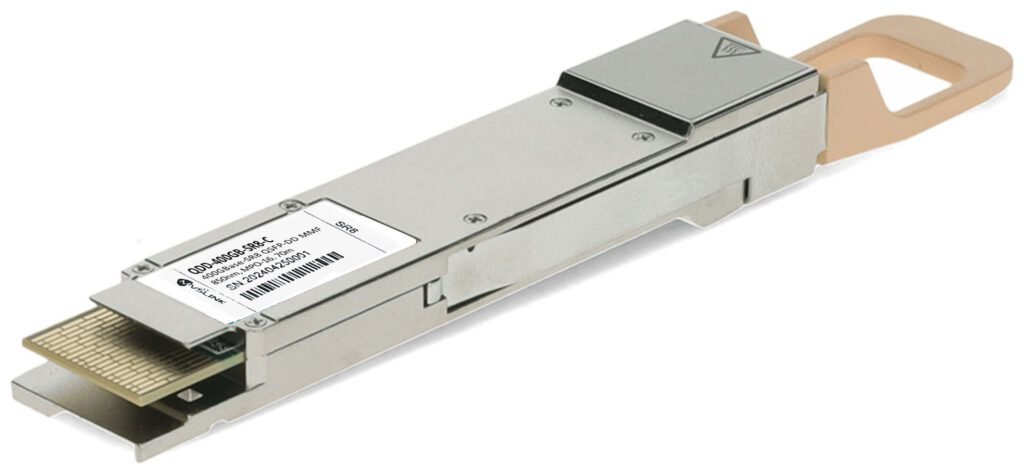Cloud and AI applications have driven the need for data rates exceeding 100 Gb/s, leading to a shift towards high-speed, low-power 400 Gb/s connections. To support the short-reach application space inside data centers, the fiber optics industry has developed two IEEE 400G Ethernet standards: 400G SR4.2 and 400G SR8.
Table of Contents
Toggle400G SR4.2
400G SR4.2 is a 4-pair, 2-wavelength multimode solution that supports transmission distances of 70m (OM3), 100m (OM4), and 150m (OM5). It is the first IEEE 802.3 solution to use multiple fiber pairs and wavelengths. It is also the first Ethernet standard to use two short wavelengths to increase multimode fiber capacity from 50 Gb/s per fiber to 100 Gb/s.
400G SR4.2 uses the same cabling as 40G SR4, 100G SR4, and 200G SR4. Each fiber supports bidirectional transmission, with each wavelength traveling in opposite directions. Therefore, each active position in the transceiver acts as both a transmitter and a receiver, creating a bidirectional optical setup with eight optical transmitters and eight optical receivers in 400G SR4.2.

400G SR8
400G SR8 is an 8-pair, single-wavelength multimode solution that supports transmission distances of 70m (OM3) and 100m (OM4 and OM5). It is the first IEEE fiber optic interface to use 8 fiber pairs. Unlike 400G SR4.2, it operates on a single wavelength (850nm), with each pair capable of transmitting 50 Gb/s. It also has two optical channel arrangement variants: a 24-fiber MPO configured in two rows of 12 fibers, and a single-row MPO-16.
Additionally, 400G SR8 offers flexibility and higher density, supporting fiber shuffling in 50G/100G/200G configurations, and fan-out for various I/O speeds to suit different applications. The 400G SR8 QSFP-DD transceiver can be configured to operate as 400G SR8, 2x200G SR4, 4x100G SR2, or 8x50G SR.


400G SR4.2 vs. 400G SR8
Although 400G SR4.2 and 400G SR8 are both multimode solutions for 400G Ethernet, they exhibit some common features and significant differences, as shown in the table below.


| 400GBASE-SR4.2 | 400GBASE-SR8 | |
|---|---|---|
| Alliance | IEEE 802.3cm | IEEE 802.3cm (breakout: 802.3cd) |
| Max reach | 150m over OM5 | 100m over OM4/OM5 |
| Fibers | 8 fibers | 16 fibers (ribbon patch cord) |
| Wavelength | 2 wavelengths (850nm and 910nm) | 1 wavelength (850nm) |
| BiDi technology | Support | / |
| Signal modulation format | PAM4 signaling | PAM4 signaling |
| Laser | VCSEL | VCSEL |
| Form factor | QSFP-DD, OSFP | QSFP-DD, OSFP |
While 400G SR8 technology is simpler, it requires a 16-fiber ribbon cable. It typically employs 8 VCSEL lasers without gearbox, thereby reducing overall costs of modules and fibers. In contrast, 400G SR4.2 is technically more complex, resulting in higher overall costs for related fibers or modules, but it can support longer distances.
Boosting Higher Speed Ethernet with 400G SR4.2 and 400G SR8
Both 400G SR4.2 and 400G SR8 support 400G Ethernet and offer scalable multimode fiber connectivity. As multimode fiber evolves to meet growing speed and capacity demands, these optical solutions ensure feasibility for various demanding applications.
With the adoption of the two IEEE 802.3cm standards, it provides a smooth pathway for Ethernet evolution to enhance cloud-based services and applications. These future advancements indicate that as they progress to the next level, they will be capable of supporting higher data rates. Ultimately, 400G SR4.2 and 400G SR8 pave the way for the future of 800 Gb/s Ethernet.
MVSLINK (Suzhou Weimei Electronic Technology Co., Ltd. ) is a 12+ years old optical module supplier with a factory, dedicated to providing high-quality optical modules and professional communication solutions for all customers, offering 1 piece OEM service.
For more information or a quote, contact us or visit the 400G multi-mode fiber product page.

